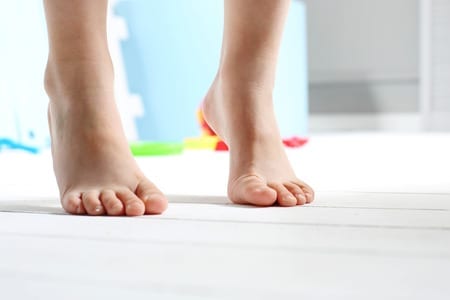Children’s feet are the corner stone to stability and lower leg mechanics. As children grow, they can be faced with a number of foot problems that affect lower leg mechanics. Many of them are common and will correct themselves with time, whilst others should be treated early for the most effective outcomes.
When should children visit a podiatrist?
If you have any concern regarding your child’s feet or lower legs then you should seek advice from our podiatrists. No issue is too small and our podiatrists can diagnose treat all children’s foot problems including gait issues, ingrown toenails and warts.
If your child is suffering from any lower leg symptoms, exhibits an awkward gait or walk, has flat feet, uneven shoe wear, poor posture and stability then you should schedule a consultation with one of our podiatrists. No age is too young to visit our Enable Podiatry clinic.
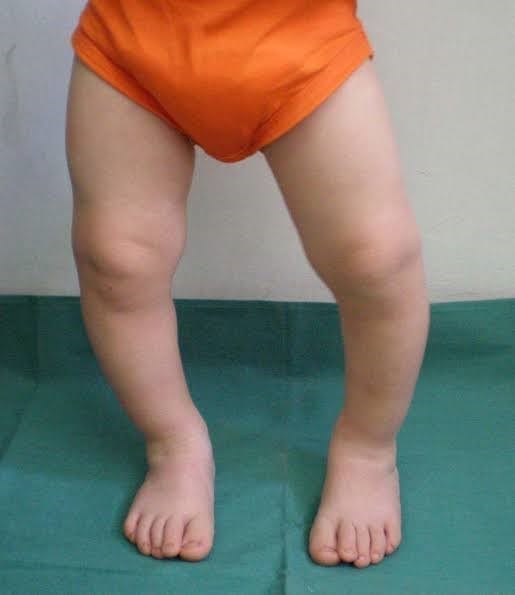
What are Bow Legs?
Bow legs, medically known as genu varum, refers to the condition when a child stands with their ankles close together and their knees far apart. Bow legs are common in infants, due to the position in uterus, but by the age of two the bow legs should ideally have straightened significantly. If bow legs are excessive or if they persist into childhood and adolescence it can lead to excess foot pronation, flat feet and lower leg problems.
Signs & Symptoms
- Child’s ankles are close together whilst the knees are apart during walking or standing
- You may notice excess wear on the outer heels of your child’s shoes
- Bow legs may be asymmetrical or symmetrical
- You may notice that your child has flat feet
- Bow legs are mostly asymptomatic but flat feet can lead to other problems
Causes of bow legs (genu varum)
Bow legs are common in newborns and infants due to the position of the legs in the uterus. The bowing should ideally straighten by the age of 2. Those children over 2 years of age who still have significant bowing in the legs usually have a genetic cause.
Bow legs that don’t straighten or get worse after birth often have a more serious underlying medical cause.
Factors that can cause bow legs include:
- Genetics
- Rickets – a bone disease caused by a lack of vitamin D, calcium or phosphorus
- Blount’s disease – a growth disorder of the tibia (shin bone)
- Injury or infection
Flat feet are often associated with bow legs so you should always seek assessment with one our children’s podiatrists even if you think the bow legs may be normal in your child.
Podiatry Treatment for bow legs (genu varum)
Our podiatrists are experts in children’s foot problems including bow legs. Whilst bow legs are common in infants, excessive bowing, asymmetrical bowing or bow legs that worsen with age, will generally require assessment and intervention. Treatment is aimed at treating the underlying cause and any associated problems like flat feet.
Bow legs left undiagnosed or untreated could potentially lead to arthritis in the knees and hips later in life.
Treatment options include:
- Children’s orthotics
- Footwear advice
- Addressing postural issues
Children’s orthotics work by improving foot alignment and foot function. This improves knee and lower leg alignment and can help reduce excess shoe wear often caused by bow legs.
Referral for special orthopaedic braces or surgery is usually only required in more severe cases and those cases of bow legs caused by an underlying medical disease.
Consultation with a podiatrist is strongly recommended if you notice excessive bow legs (genu varum) in your child after the age of 2.

Flat feet refers to a condition where the arches of the feet flatten or collapse excessively. When this condition occurs in children it is know as paediatric flat foot or paediatric pes planus.
This common children’s foot condition can be either symptomatic or asymptomatic. As well as low or flat foot arches you may also notice excess rolling in of your child’s ankles. Symptoms occur because flat feet function poorly, placing added strain on children’s muscles and ligaments. This can lead to sore or tired feet and legs in children. Paediatric flat feet is a common causative factor in children’s foot, ankle, knee, hip and back pain.
Signs & Symptoms
The following signs or symptoms may indicate a paediatric flat foot:
- A collapsing, low or flat arch present on one or both of your child’s feet when standing
- Excess rolling inwards (excess pronation) of one or both of your child’s ankles when they walk
- You may notice your child walks with an awkward gait
- Paediatric flat feet can be symptomatic or asymptomatic
- Your child may complain of sore or tired feet and legs
- Your child may choose not to participate in activities
- Your child may report pain or cramping under the arch
- Sometimes your child may even complain of night pains or growing pains in the legs
- You may notice excessive wear on your child’s shoes
- You may notice bony lumps on top of your child’s arch or poor alignment of the toes
Causes of paediatric flat feet
Paediatric flat feet are mostly hereditary in nature and caused by genetic factors that affect the way the foot functions. For this reason you may notice that another member of the family or a member in a past generation may also have or had flat feet. Some paediatric flat feet can still be acquired and these are generally the result of poor posture, gait, lower leg alignment or injury.
Some common characteristics that can affect foot structure and lead to a paediatric flat foot include:
- Flexible or hypermobile joints and ligaments
- Abnormality of the bones in the feet
- Low muscle tone
- Tight calf muscles
- Poor hip or leg alignment leading to a poor angle of gait
- Acute injury
Most paediatric flat feet are generally flexible in nature but some may be rigid if caused by a bony abnormality, such as coalition (when 2 bones join together).
Treatment for paediatric flat feet
The our podiatrists are experts in children’s foot problems including paediatric flat feet. Treatment options at our clinic include:
- Children’s orthotics
- Footwear advice
- Addressing postural issues
- Strengthening and stretching
Children’s orthotics work by restoring the foots natural arch and alignment whilst improving foot function. This helps improve a child’s posture and stability thereby reducing strain on joints and lower leg muscles.
Orthotic treatment for paediatric flat feet may be short term or long term depending on the severity and the cause. A mild flat foot deformity may be corrected with early podiatry intervention but more severe flat feet and will likely require long term orthotic wear to help support the foot, protect foot structure and prevent future symptoms.
If children’s flat feet are not supported then it will cause poor bony alignment of the bones in the feet, potentially leading to cartilage degeneration, arthritis and foot joint deformities such as bunions.
So if you think your child may have flat feet it is vitally important you get their feet accurately assessed by one of our podiatrists.
A podiatrist is the best health professional to diagnose and treat paediatric flat feet.

What are growing pains?
Growing pains are a common children’s condition causing muscle pains in the legs at night. They are thought to coincide with children growth spurts (however there is no firm evidence it is linked) hence the name “growing pains”.
Growing pains can be a problem for both children and parents. They are most common in the muscles of the calves, thighs and behind the knee. Episodes are usually spasmodic and symptoms can range from a mild ache or cramp to a child awakening at night screaming in agony.
Signs & Symptoms
The following signs or symptoms may indicate growing pains in a child:
- Muscular pain present in the child’s thighs, calves or behind the knees
- Episodes are usually spasmodic
- Pain usually occurs at night and may interrupt children’s sleep
- Pain is gone by the morning and does not interfere with daily activities
- Pain can range from a mild ache, to a cramp, to a severe pain causing the child to scream in agony
Causes of growing pains
There are many theories as to what causes growing pains. Some think its related to muscle fatigue whilst others feel it could be related to restless leg syndrome. The theory that it is due to children’s growth spurts or growth periods has limited supporting evidence.
In our opinion the most likely cause of children’s growing pains are muscle overuse and fatigue. This theory is also supported clinically. Most growing pain cases our children’s podiatrists see at our clinic involve pre-school children aged 3-5. During these ages a child’s muscles aren’t fully developed and strong enough to deal with daily loads and activity. The end result is muscle overuse and fatigue resulting in muscular pains and cramps at night. Growing pains usually stop once a child gets older and their muscles get strong enough to cope with daily activities.
Factors that may make children more prone to growing pains include:
- Low muscle tone
- Ligamentous laxity
- Tight muscles causing overuse of opposing muscles
- Poor foot and lower leg function
Flat feet or poor foot function places more strain on children’s lower leg muscles. For example a foot that rolls in or pronates too much will place more strain on those muscles that are designed to oppose this movement. Excess strain on lower leg muscles can then lead to muscle fatigue and potential growing pains at night.
Treatment for growing pains
Our podiatrists are experts in treatment of children’s growing pains. Podiatry treatment is aimed at improving stability, strength and flexibility of muscles whilst reducing strain on lower leg muscles. Treatment options include:
- Children’s orthotics
- Footwear advice
- Stretching and strengthening
Orthotics improve foot function which helps align children’s lower legs, making them more stable. The end result is that lower leg muscles work more efficiently with less strain and therefore don’t fatigue as quickly. Clinically our children’s podiatrists find that accurately prescribed orthotics have a significant impact on reducing the intensity and frequency of growing pains in children with poor foot mechanics.
NB. Pain in a child’s leg at night should always be taken seriously as it may be due to other more serious causes.
What is in-toeing?
In-toeing is a common children’s gait condition which occurs when a child walks with one or both feet turned inward. Commonly known as a ‘pigeon-toed’ gait, it is most prevalent in children aged under 4. In-toeing is generally asymptomatic but severe cases of in-toeing can cause tripping.
Signs & Symptoms
The following signs or symptoms may indicate an in-toeing children’s gait:
- One or both feet turn inwards when your child walks or runs
- You may notice squinting knees or turned in knees when your child stands or walks
- You may notice “banana” or curved shaped feet
- You may notice that your child looks clumsy or trips over their feet when walking
Whilst in-toeing is usually asymptomatic in some cases it can be a source of embarrassment for the child which may then lead to low self esteem and affect their participation in activities.
Causes for in-toeing
Paediatric in-toeing can be caused by one or a combination of 3 main conditions as outlined below:
Metatarsus Adductus
Metarsus adductus occurs when a child’s foot is turned inward. The forefoot is adducted or curved inward relative to the rearfoot. This causes the foot to have a “banana” or curved shaped appearance and will likely lead to an in-toeing gait when a child walks.
Internal Tibial Torsion
Internal tibial torsion occurs when the lower leg bone (tibia) is turned inward relative to the knee joint. This condition may be present in one or both legs and will lead to an in-toeing children’s gait.
Internal Femoral Torsion
Internal femoral torsion occurs when the thigh bone (femur) is turned inward relative to the hip joint. This causes a child’s knees to turn inward when walking and will likely also result in the feet turning inward causing in-toeing when a child walks.
Other factors that may cause in-toeing in combination with the above include:
- Genetics
- Poor postural positions
- Tight muscles
- Low muscle tone
- Injury
Treatment for in-toeing
Our podiatrists are experts in treatment of children’s foot problems including in-toeing. Treatment outcomes for paediatric in-toeing are better if treated early and often only parent assurance and education is sometimes all that’s required.
Podiatry treatment options for in-toeing children include:
- Addressing postural issues
- Children’s orthotics including gait plates
- Stretching and strengthening
Gait plate orthotics have an extended lateral (outside) section and work by proprioception. Basically it is more comfortable for the child to walk out-toed rather than in-toed when wearing the devices. Gait plates will not correct in-toeing (addressing other factors will) but can help a child walk straighter when wearing them. This improves aesthetics, helps reduce associated tripping, and also improves a child’s self esteem.
Whilst children’s in-toeing is generally asymptomatic and most cases will resolve spontaneously, other cases may remain or get worse if the cause is not addressed, so assessment with a podiatrist is essential.
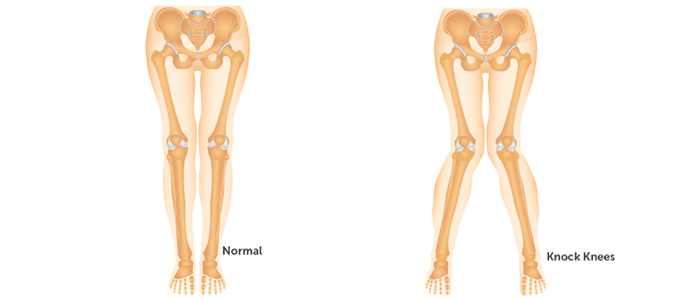
What are Knock Knees?
Knock knees, medically known as genu valgum, refers to the condition when a child is standing with their knees together whilst their feet are far apart. This condition is common in children and a part of their natural development, especially at age 3-4. If knock knees are excessive or persists into late childhood it can lead to excess foot pronation, flat feet and poor lower leg mechanics.
Signs & Symptoms
The following signs or symptoms may indicate knock knees in children:
- Child’s knees are close together or touching whilst the feet are apart during walking or standing
- You may notice that your child has flat feet
- Knock knees are mostly asymptomatic but flat feet can lead to other problems
Causes for knock knees (genu valgum)
Knock knees are common in children under the age of 7 and are a natural part of childhood development. Knock knees usually peak at their worst around 3-4 years of age and are often worse in females. As the child grows knock knees will usually straighten.
Knock knees that persist into late childhood and adolescence are usually the result of genetics. Whilst knock knees that don’t improve or get worse with age usually have an underlying medical cause.
Factors that can cause knock knees include:
- Genetics
- Rickets -a bone disease caused through a lack of vitamin D, calcium or phosphorus
- Injury or infection
- Obesity or excess pressure on the knees
Treatment for knock knees (genu valgum)
Our podiatrists are experts in children’s foot problems including knock knees. Whilst knock knees are part of a child’s natural development, persistent or excessive knock knees will generally require intervention. Treatment is aimed at treating the underlying cause and any associated symptoms or problems like flat feet.
Treatment options at our clinic include:
- Children’s orthotics
- Footwear advice
- Addressing postural issues
- Strengthening and stretching
Children’s orthotics work by improving foot alignment and foot function. This reduces internal knee rotation, improves knee and lower leg alignment, and helps to reduce the knock knee deformity.
Referral for surgery is usually only required in the most severe cases of knock knees.
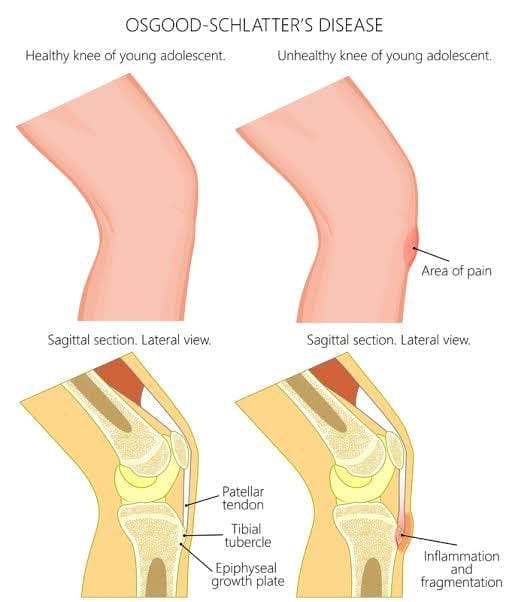
What is Osgood-Schlatter disease?
Osgood-Schlatter disease, also known as tibial tubercle apophysitis, is a common cause of knee pain in adolescent children aged 10 to 18. It is caused by excess strain on the growth plate of the tibia from the patella tendon in the knee, leading to pain and inflammation.
The child or adolescent will usually complain of pain at the front of the knee just below the patella and often there is a noticeable swelling or lump in this area.
Signs & Symptoms
- Pain in one or both knees below the knee cap
- There may be a noticeable lump or swelling in the region of pain below the knee cap
- Symptoms are usually worse during and after activity
- Running, jumping, kneeling or stairs will often exacerbate symptoms
- In severe cases symptoms may cause the child to limp
Causes for Osgood-Schlatters disease
Osgood-Schlatter disease is caused by excess strain on the growth plate of the tibia from the patella tendon, which attaches the knee cap to the tibia (leg bone). It occurs in teenagers and adolescents who are experiencing growth spurts and is more common in active and sporty children. Osgood-Schlatter disease will resolve once the child stops growing.
Factors that can increase strain on the growth plate or tibial tubercle include:
- Sports or activities that involve running, jumping, or repetitive knee bending
- Poor foot mechanics or flat feet
- Poor footwear
- Tight leg muscles
Flat feet or poor lower leg mechanics is often an overlooked factor in Osgood-Schlatter disease. Excess foot pronation (rolling inwards) causes excess internal rotation of the tibia, thereby increasing torque and strain on the knee, the patella tendon and the tibial tubercle growth plate, exacerbating Osgood-Schlatters symptoms.
Treatment for Osgood-Schlatters disease
Our podiatrists are experts in children’s lower leg and foot problems including Osgood-Schlatter disease. As this condition will resolve once the tibia bone stops growing treatment is aimed at management and reducing symptoms, so the child can continue with sport and daily activities.
Treatment options at our clinic include:
- Children’s orthotics
- Footwear advice
- Addressing postural issues
- Strengthening and stretching
Orthotics can significantly help reduce Osgood-Schlatter symptoms in those children who have flat feet or poor biomechancis. Orthotics reduce excess foot pronation and improve lower leg mechanics. This reduces internal leg and knee rotation, resulting in less strain on the patella tendon and the tibial growth plate.
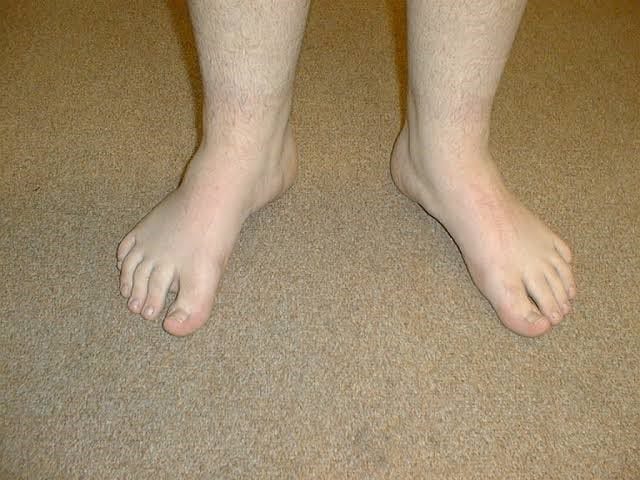
What is Out-toeing?
Out-toeing or excess abduction is a children’s gait condition which occurs when a child walks with one or both feet turned excessively outward. Out-toeing is the opposite to in-toeing and commonly referred to as having “duck feet”. It can cause an apropulsive gait and the child may look clumsy when walking and running. An out-toeing gait is often associated with a paediatric flat foot and may lead to other lower leg problems.
Sign & Symptoms
The following signs or symptoms may indicate an out-toeing children’s gait:
- One or both feet turn excessively outwards when your child walks or runs
- You may notice that your child’s knees point outwards when standing or walking
- You may notice that your child looks clumsy or apropulsive when walking or running
- Your child may appear to have duck feet and even waddle like a duck when walking
- You may notice that your child has flat feet
- Out-toeing is mostly asymptomatic but flat feet can lead to other problems
Causes of out-toeing
Paediatric out-toeing can be caused by one or a combination of the conditions outlined below:
External Tibial Torsion
External tibial torsion occurs when the lower leg bone (tibia) is turned excessively outward relative to the knee joint. It is normal to have a little external tibial torsion and most children should ideally walk with their knees straight and feet turned out slightly from the age of 4. However too much external rotation will result in out-toeing or an excessively abducted gait.
External Femoral Torsion
External femoral torsion occurs when the thigh bone (femur) is turned outward relative to the hip joint. This will cause a child’s knees to point outward instead of straight when walking and will likely result in the feet also turning outward causing an out-toeing gait.
Paediatric flat feet
If your child has flat feet then depending on the severity they may also have an abducted or out-toeing gait. When the arch of the foot collapses it causes the midfoot to collapse and the forefoot to abduct (turn out). Therefore the flatter the foot the more likelihood of also noticing an out-toeing gait.
Other factors that may cause out-toeing in combination with the above include:
- Genetics
- Poor postural positions
- Tight muscles
- Low muscle tone
- Injury
Treatment for out-toeing
Our podiatrists are experts in treatment of children’s foot problems including out-toeing. Early treatment with our podiatrists will deliver best results for your child.
Podiatry treatment options for out-toeing children include:
- Addressing postural issues
- Children’s orthotics
- Stretching and strengthening
Orthotics work by supporting your child’s foot and natural arch, leading to improved foot function. This reduces forefoot abduction, so in cases of out-toeing with associated flat foot deformity an orthotic will improve the angle of gait and your child will walk straighter.
What is Sever’s disease?
 Sever’s disease, also known as calcaneal apophysitis, is a growing condition causing heel pain in children. It is caused by excessive muscle strain on the growth plate of the heel bone.
Sever’s disease, also known as calcaneal apophysitis, is a growing condition causing heel pain in children. It is caused by excessive muscle strain on the growth plate of the heel bone.
Sever’s disease is most common during children’s growth years around ages 8 – 14 and slightly more prevalent in boys than girls. Symptoms are generally worse after sport or activity, especially sports that involve a lot of running or jumping.
Signs & Symptoms
The following signs or symptoms may indicate Sever’s disease in a child:
- Pain or swelling in one or both heels
- Pain is usually worse after sport or activity but can also occur during the activity
- Symptoms are usually worse with running and jumping activities
- Pain may cause the child to limp or avoid placing pressure on the heel
- Pain is better with rest
Causes of Sever’s disease
Sever’s disease is caused by excessive strain on the growth plate of the heel bone by the Achilles tendon, which is the tendon that attaches the calf muscle to the heel bone. This leads to pain and swelling in the growth plate of the heel (calcaneus).
Growth plates are soft areas of cartilage where new bone grows from. Excess traction on these areas by tendons cause swelling and pain within the soft bone. Sever’s disease will resolve once the growth plate of the heel closes or stops growing. The soft bone is turned into hard bone and less prone to traction.
Not all children will get Sever’s disease but those that have tight calf muscles and poor foot function are often more prone as these factors increase strain on the growth plate.
Poor foot function or flat feet causes a child’s foot to pronate excessively or roll in. This causes bowing and excess strain on the Achilles tendon. Excess pronation will result in more traction by the Achilles at its insertion in the growth plate of the heel, potentially leading to Sever’s pain.
Treatment for Sever’s Disease
Our podiatrists are experts in the treatment of children’s foot problems including Sever’s disease. Treatment is aimed at limiting and managing symptoms until the child grows out of the condition, so the child can continue their daily activities and participate in sport with minimum pain.
- Children’s orthotics
- Footwear advice
- Strengthening and stretching
Children’s orthotics work by supporting the foots natural arch, whilst improving foot function and alignment. This helps to improve and straighten the line of pull of the Achilles tendon, reducing strain on the muscle. This results in less traction on the growth plate and a reduction in heel pain symptoms for the child.
Sever’s disease symptoms can last anywhere between 6 months and 2 years and can greatly affect a child’s daily activities as well as participation in sport, so don’t delay in seeking podiatry treatment if your child suffers from heel pain.


